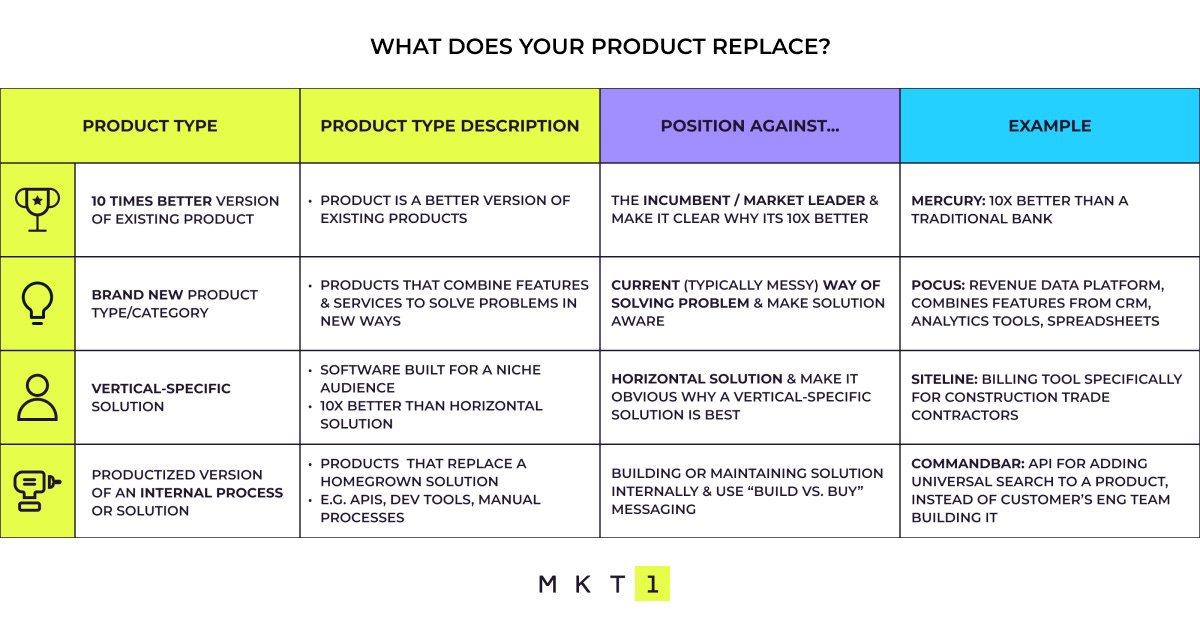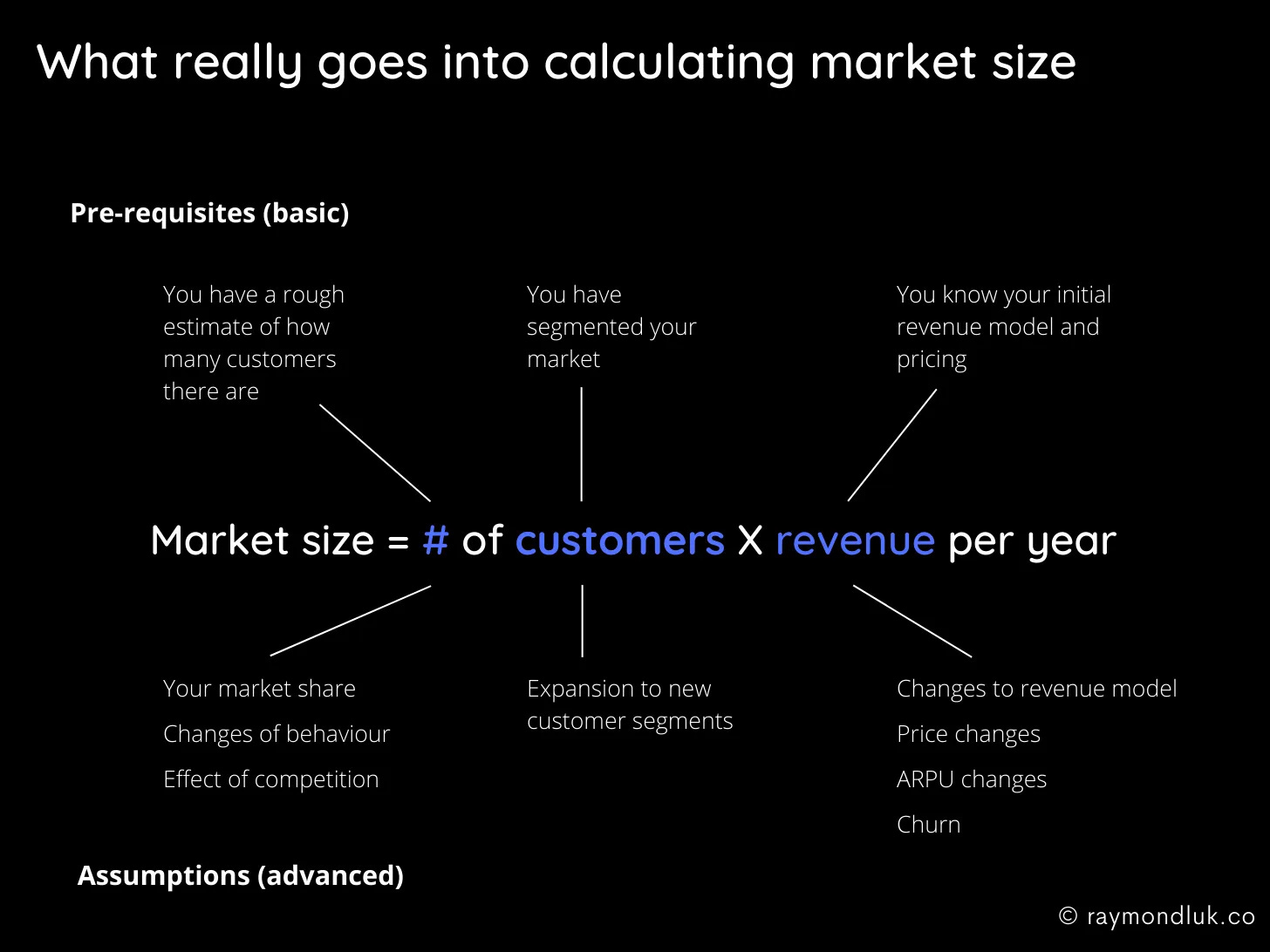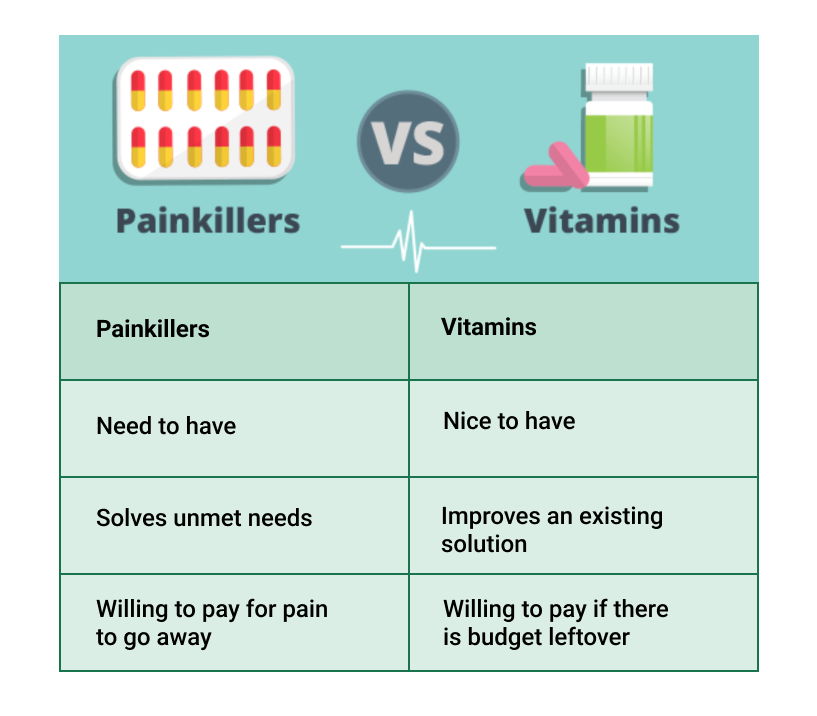Collection of Writings on Startups
May 6, 2023 . 13 min read
Picking Ideas
🤔 Evaluating Ideas
TLDR: Validate Problem -> Validate Innovation -> Validate Product
- Utility (Validate the problem space)
- Most good ideas do not solve an entirely new problem.
- Ideally this is a big space with an established player.
- e.g: Consumer audio - People listen to their favorite music on walkman and speakers.
- Innovation (Validate the solution space)
- Most good ideas are a new and better way of solving the same problem.
- Generally, here you are looking for a recent technology or industry change that provides new ways to solve an old problem.
- Here, you also need to evaluate if the underlying trend is here to stay or a fad.
- e.g: People want to consume more music but find it difficult to carry around casettes. e.g: Wireless audio player with inbuilt memory.
- Usability (Validate the product)
- Combination of killer features.
- e.g: itunes store to buy music, touch screen to select music, inbuilt memory, rechargeable battery, etc.
Sam Altman's questions to ask for startup idea validation
- Is this something that is possible this year and was not possible last year? (Y/N)
- Will next year be too late? (Y/N)
- I am sure this is going to happen, I am not just sure if we will be the ones to do it. (Y/N)
- Articulate why most people think it's a bad idea, but you understand what makes it good (Detailed)
Sam Altman on Idea Generation
Double Diamond Approach to Finding Solutions
- Problem Discovery - Study the problem space. Understand different ICP's. Breakdown the space by smaller problems faced by each ICP. e.g: Problem Space: Learning a new language. Problems Faced: Finding a tutor, Maintaining Continuity, etc.
- Problem Definition - Rank problems by severity, satisfaction with current alternatives, monetization potential. Pick a problem and define it further.
- Solution Discovery - Explore different solutions to the problem. Brainstorm ideas.
- Solution Definition - Rank solutions by feasibility, effort, novelty(innovation), solution capability(usability), WTP. Define the final solution.
Danny on identifying painkillers vs vitamins
- The easiest products to sell are those that save time, money or increases someone's social status.
e.g:
- Headshotpro does all three.
- save money → cheaper than physical shoot
- save time → just upload few selfies
- increase status → more professional look
Source: Danny's Tweet
What does your product replace?

🎙️ User Insights & Interviews
The 4-step User Interview Framework
The Who
- Who is this person?
- What are the big decision buckets he falls in?
- What are the small decisions he takes?
- What motivates the big decisions and the small decisions?
- Does he value time or money?
The What & The Why/The Why not
- What are his challenges and pain points in context
- What is not a challenge in context
- Why is this important for him
- Why is this not important for him (Competition, Satisfaction w. current alternatives)
The How
- How does he solve this problem today?
- How happy he is with the current way of doing things?
- What does he like about and what does he not like about it?
- What is the risk & reward for a good solution vs a bad solution?
The When
- When does he use the solution?
- What is the frequency of using the solution?
- Is this a sequenced problem/complementary product etc? (This problem generally is followed by some other problem)
Does your product have a natural trigger?
Triggers can be categorized as artificial and natural. Artificial triggers encompass notifications and reminders of various types. Conversely, natural triggers already exist in our surroundings. Any behavior or product that utilizes a natural trigger tends to be more enduring. For instance, feeling hungry leading to Zomato, or boredom guiding you to platforms like YouTube or Netflix, and needing transportation bringing you to Uber.
During user interviews, a crucial aspect is to uncover the natural triggers pertinent to your target audience's behavior or product usage. Subsequently, the objective is to market and communicate your product as the preferred choice when the natural trigger occurs. For instance, when planning a vacation, a user might consider both Booking.com and Airbnb.com. Your role here is to ensure your company becomes synonymous with that trigger in the long term.
🅰 Defining the Problem Statement
Always start with the problem statement which acts as an initial hypothesis that can be further proved or disproved. To understand broader user level problems deeper analysis of user behavior and needs is required.
Dave Bailey’s needs narrative template is a great resource here to think about user needs and problem in depth. It covers the different aspects that need to be defined to get a complete understanding of the problem.
For ___[target audience], it’s a constant challenge to ___[general problem]. Every ___[time period], these people ___[perform a key activity] in order to ___[achieve a primary goal]. This is especially true if you’re a [niche].
The main problem they face is ___[primary functional problem relating to activity] which leads to ___[bad/worst case outcomes]. Today, their best option is ___[substitutes], but of course, they ___[the most common complaints of each substitute]. With ___[key trend], the problem will only get worse over time.
If only there was an easier/better/cheaper way to ___[perform a key activity], then customers could ___[quantifiable impact on their primary goal] which would lead to ___[positive outcomes/emotions]. With ___[number of potential customers], there is a clear opportunity to meaningfully impact a huge number of people.
Reference: My post on problem solving
Finding Product Market Fit
🚛 Market Sizing
Simplest Way To Think About A Market

Reference: The Market Size Dilemma
🥅 Goal Setting
Tldr: Validate Want -> Validate Usage -> Validate WTP -> Validate easy acquisition
A mental model for thinking about getting to True Product-Market Fit is to imagine a series of milestones that give you increasing confidence in your business:
- Milestone #1: One person wants your product
- Milestone #2: Many people want your product
- Milestone #3: Many people continue to use your product
- Milestone #4: You can acquire new users efficiently
- Milestone #5: You make money from people using your product
- Milestone #6: You make a profit from people using your product
Reference: Lenny's Tweet
💸 Monetization
Tldr: One time payment (Validate WTP) -> Add features -> Move to MRR
My preferred way to monetise products:
- Initial low-cost, one-time payment
- Attract customers with feedback potential
- Implement necessary features
- Charge monthly recurring fees when product gets better
Reference: Danny's Tweet
Resource 1: Paywall Screen Design Inspiration
Other Monetisation Strategies
- When the competition is expensive/high-priced: Offer free or cut on prices. Offer ads on your website that redirect to your competitors paid products. e.g: PlentyOfFish
- When the competition is free/low-priced: Pick a small under served yet important niche. Look for customer segments that have WTP for solving the problem. e.g: Language Learning Companion App But Sold To Schools instead of consumers.
Source: Luke's Tweet
✅ Measuring Success
Tldr: >7-10% WOW growth = Early signs of PMF
When we start a new product line at Replit, we run the YC 7-10% week-over-week growth formula. When you overshoot, like with Ghostwriter growing 30% w/w, you know there is an exceptional product-market-fit.
Reference: Amjad's Tweet
Sean Ellis Survey to Measure PMF
Sean Ellis identified product/market fit by asking users how they'd feel without the product, with a 40% "very disappointed" response rate being the threshold. Companies below this rate struggled, while those above experienced strong growth.
Resource: Sean Ellis PMF Survey Sample & Tool
📈 Growth Inflections
Tldr: Major growth inflections happen either due to sudden PMF, doubling down on a channel or external factors.
- The majority of growth inflections sprang from a product improvement (e.g: Mobile app launch for Duolingo/Facebook, Team Library feature for Figma, Stories/Ephemeral messaging/Face Filters for Snap)
- A surprising number of growth inflections came from an unexpected external event, without the product changing at all (e.g: Pandemic -> Clubhouse)
- Many of the most durable inflections came from the company leaning into their primary growth engine (e.g. SEO, virality)
Reference: Lenny's Post
Product Growth
Finance owns the flow of cash in and out of a company. Growth owns the flow of customers in and out of a product.
Acquisition x Activation x Retention x Churn x Resurrection x Monetization = 🌱
0️⃣ Growth Equation
The first step of defining a growth strategy is to understand the business's growth equation. This gives us an idea of how the business currently grows. Once we have this understanding we can target different levers to trigger growth.
Framework to find your growth equation: Sustainable Growth = Top of Funnel X Magic Moment X Core Product Value
Some Examples:
-
Amazon's Growth = (Vertical Expansion) X (Product Inventory per Vertical) X (Traffic Per Product Page) X (Conversion to Purchase) X (Average Purchase Value) X (Repeat Purchase Behavior)
-
Taaza's Growth = (Vertical Expansion - Content Categories) X (Videos per Vertical) X (Installs) X (Engaged Users) X(Daily Minutes watched per user) X (Days Active) X (Ad revenue per user)
-
Lensa's Growth = (Installs) X (Engaged Users-Weekly Active User) X (ARPU) X (Repeat Usage Behavior) X (Category Expansion e.g Profile Pictures, Couple Pictures) X (Product Per Category e.g: Shareable Pics, Wallart, Mugs, etc.)
Reference: Andy's Post
🔁 Acquisition: Growth Loops
Growth loops are better than funnels. Growth loops help products grow organically. A successful growth loop has 3 elements:- Input, Action, Output.
There are 2 types of loops: Micro loops: Operational loops you are using to attract and retain users. Macro loops: Strategic loops paired with micro loops to drive additional growth.
Common Micro Loops:
- Viral loops: One person leads to another person signing up
- Content loops: Content brings in signups which enables more content
- Paid loops: Ads bring in signups which enables more ads
Common Macro Loops:
- Direct network effects: When value to a user increases as more people use the product
- Cross-side network effects: When value to one type of user increases as more users of another type use the product
- Data network effects: When the quality or cost of the product improves as more - usage data is collected
- Economies of scale: When volume grows, returns increase leading to more volume
- Brand: When social capital is built through other compounding loops
Examples:
-
Magic Avatars
- Input: New/Returning User
- Action: Creates a Magic Avatar
- Output: Updates DP on Social Media/Shares Avatars on Social Media
-
AI Editor
- Input: New/Returning user
- Action: Edits their picture. Creates a Video.
- Output: Shares edited pictures on social media/chat/etc.
-
Taaza
- Input: New/Returning User
- Action: Consumes a news story
- Output: Shares a news story with friends on Whatsapp
Reference: Conor's Post
🌱 Activation & Onboarding
Tldr: Understand User Intent -> Find Activation Metric -> Reduce Friction to reach the activation metric
Basics:
- Users come to your product page to solve an immediate need.
- Activation is the process of converting a new user to an engaged user.
- Onboarding is the process that every user goes through on the way to activation.
Process:
- Map out the different core user needs. Understand why people come to you vs. competition.
- 2 Phases in User onboarding & Activation
- First Session
- Goal: Reduce Friction (Time to Value)
- Process:
- Understand the Activation Metric.
- Look at the power user to understand this. e.g: For Taaza, Power Users watched 5 news stories in the first 3 days of app install.
- Tailor the onboarding experience based on the user need and activation metric.
- Follow up Engagement
- Goal: Prompt Engagement for abandoned user
- Process:
- Explore email, push notifications, re-targeting
- Micro Copy + UX over UI
- Get the person to explore the activation metric.
- First Session
Reference: Conor's Post
Resource 1: Growth Design Case Studies
Resource 2: Growth Psychology
Resource 3: Onboarding Teardowns
Product Design
👍 Good vs Great Product Design
Elements of Good Product Design
- User Centered: user need at the core (YC Test, Making sure that the underlying problem is real)
- Functional: Does what it is supposed to do
- Intuitive: easy to use (Reduce Cognitive Load)
Elements of Great Product Design
- Solves for feelings (Great Design): Evokes the desired emotion
Other things to consider
- Aesthetically pleasing
- Responsive and adaptable (Works well across devices)
- Scalable and maintainable
- Data-driven (Built upon quantitative and qualitative research)
- Aligned with business goals
Resource 1: Essential Design Frameworks
🔮 Building Product Intuition
12 ways to make the above practical in your week-to-week:
- Use the product daily as a real user would [15 minutes / day]
- Watch one or two user research or replay sessions [10 minutes / day]
- Check your key usage metrics dashboard [5 minutes / day]
- Interview a prospective client and ask them to describe a specific workflow related to your product [30 min / week]
- Email or slack 1-3 existing clients with a specific feedback question [30 min / week]
- Read notes from recent sales calls or user interviews [30 minutes / week]
- Read customer feedback queue tickets [30 minutes / week]
- Read the latest data analysis on user behavior on your product [30 minutes / week]
- Read industry blogs / articles related to your product area, ideally about either customer learnings or from the perspective of customers [30 minutes / week]
- Explore competitor products as a real user world [2 hours / month]
- Try selling the product yourself, or tag along on a sales call [2 hours / month]
- Read 3 books a year relevant to the psychology of your customers [5 hours / week]
Source: Julie Zhuo's Post
Acquiring Users
Additional Resources
Shaan's Pitch Deck Template (Explainer Video)
ICP Definition & GTM Planning Template
